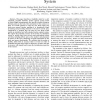SCVMA
2004
Springer
14 years 4 months ago
2004
Springer
Abstract. We show how to exploit temporal periodicity of moving objects to perform 3D reconstruction. The collection of period-separated frames serve as a surrogate for multiple ri...
INTETAIN
2005
Springer
14 years 5 months ago
2005
Springer
This paper describes Squidball, a new large-scale motion capture based game. It was tested on up to 4000 player audiences last summer at SIGGRAPH 2004. It required the construction...
ACMSE
2005
ACM
14 years 5 months ago
2005
ACM
This paper explores a method for re-sequencing an existing set of animation, specifically motion capture data, to generate new motion. Re-using animation is helpful in designing ...
WACV
2005
IEEE
14 years 5 months ago
2005
IEEE
Hand signals are commonly used in applications such as giving instructions to a pilot for airplane takeoff or direction of a crane operator by a foreman on the ground. A new algor...
ISWC
2005
IEEE
14 years 5 months ago
2005
IEEE
Abstract— This paper describes a feasibility study for a selfcontained, wearable full-body motion capture system based on time-of-flight measurements that provide absolute dista...
SI3D
2006
ACM
14 years 5 months ago
2006
ACM
Animating 3D faces to achieve compelling realism is a challenging task in the entertainment industry. Previously proposed face transfer approaches generally require a high-quality...
APGV
2006
ACM
14 years 5 months ago
2006
ACM
We present a system for realistic facial animation that decomposes facial motion capture data into semantically meaningful motion channels based on the Facial Action Coding System...
ACMACE
2006
ACM
14 years 5 months ago
2006
ACM
This paper presents a motion-capture-based control framework for third-person view virtual reality applications. Using motion capture devices, a user can directly control the full...
CIG
2006
IEEE
14 years 5 months ago
2006
IEEE
— Over recent years, the fall in cost, and increased availability of motion capture equipment has led to an increase in non-specialist companies being able to use motion capture ...
ISVC
2007
Springer
14 years 5 months ago
2007
Springer
Optical motion capture can be classified as an inference problem: given the data produced by a set of cameras, the aim is to extract the hidden state, which in this case encodes t...


